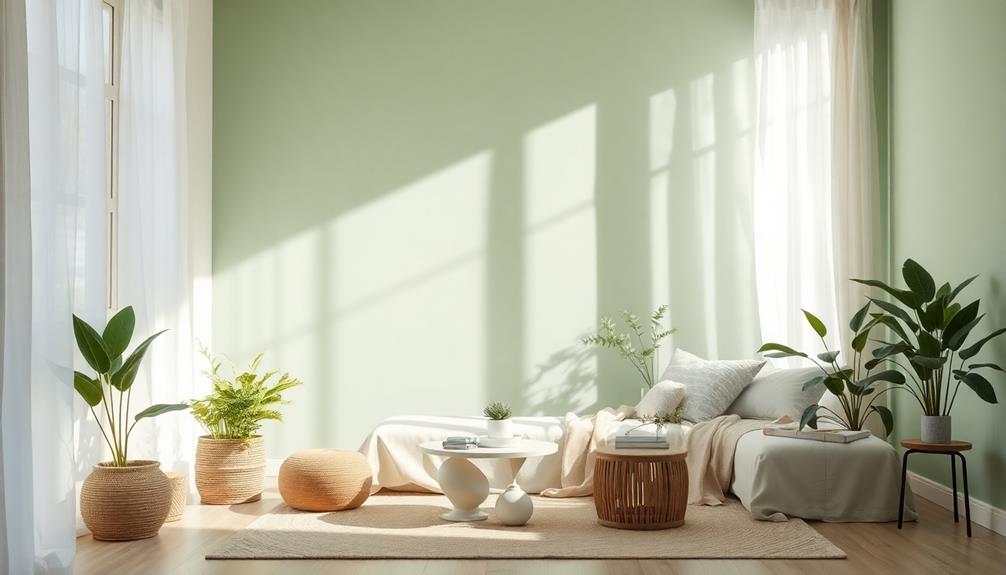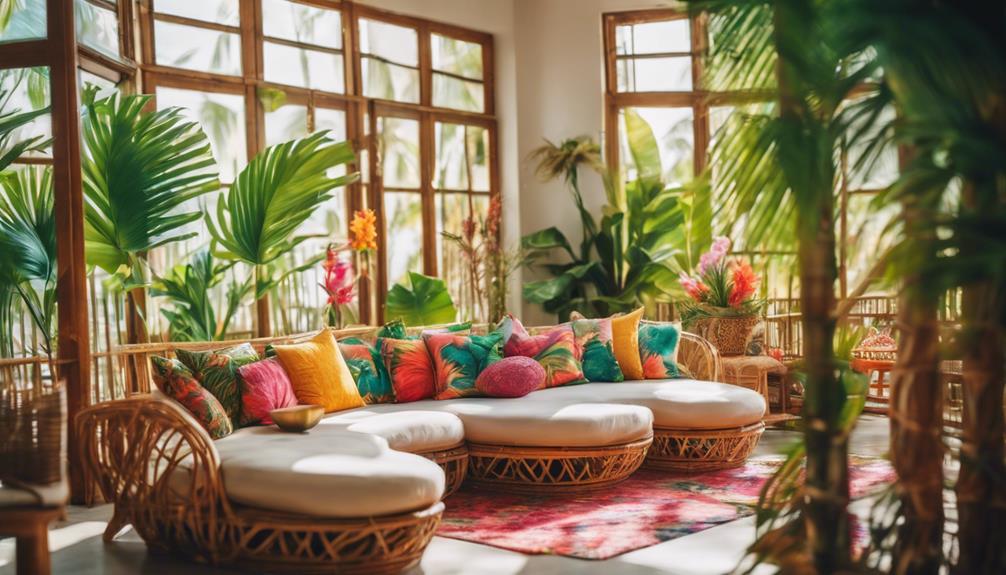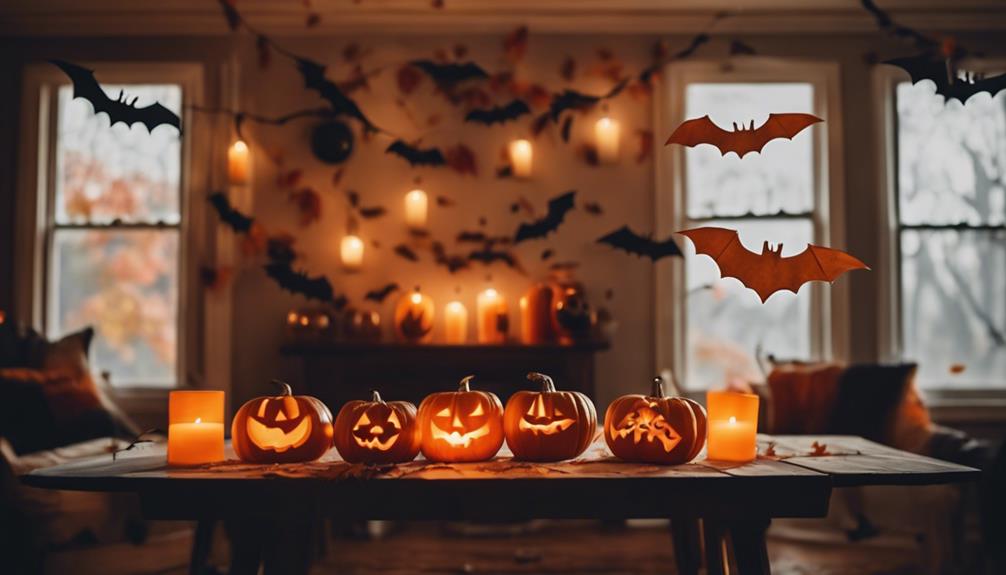Choosing the perfect colors for your space is key to enhancing Feng Shui and promoting positive energy flow. Start by understanding the emotions colors evoke: reds stimulate energy, blues foster calm, and greens promote growth. Pairing these hues wisely can create balance; for instance, combine warm tones in social areas with calming cooler shades in bedrooms. Remember to take into account the purpose of each room—blue in a home office boosts productivity, while warm colors spark lively conversations in living rooms. By exploring effective combinations, you can transform your environment into a harmonious retreat where you feel energized and serene. More insights await you!
Key Takeaways
- Choose colors based on the five Feng Shui elements to enhance energy flow and harmony in your space.
- Incorporate calming shades like blue and green in bedrooms and home offices to promote relaxation and productivity.
- Use warm colors like red and yellow in social areas to boost energy and encourage interaction, but balance them with earthy tones.
- Consider cultural color meanings to ensure your choices resonate positively in your environment.
- Regularly reassess and experiment with color combinations to maintain a balanced and inviting atmosphere in your home.
Understanding Feng Shui Principles
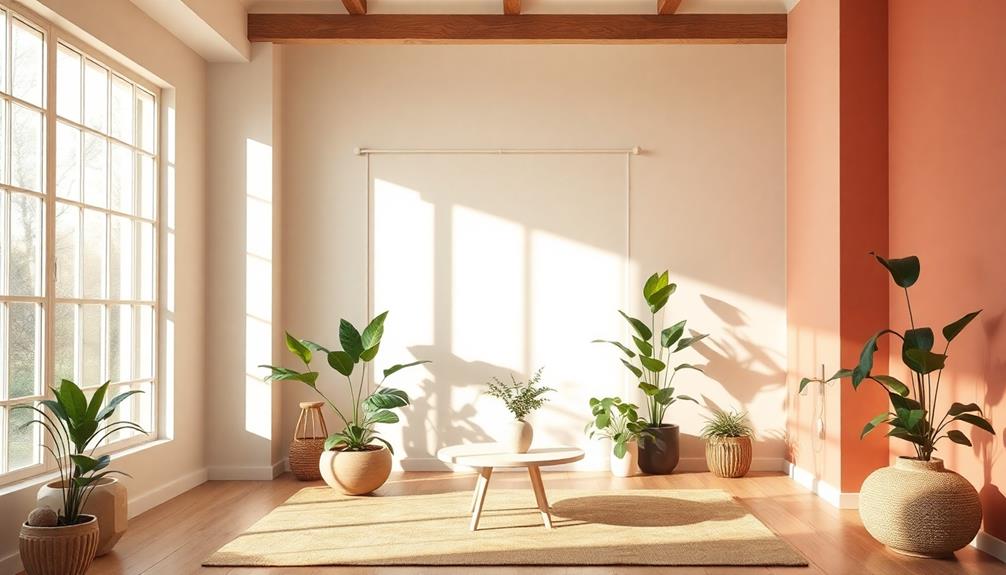
Feng Shui principles emphasize how the arrangement of your space and your color choices can shape the flow of energy, or chi, throughout your home. By understanding these principles, you can create an environment that promotes harmony and enhances your well-being. When incorporating feng shui design tips, consider positioning furniture to allow for an open and natural flow, avoiding obstacles that may block energy pathways. Choosing a calming color palette and incorporating elements like plants, mirrors, and natural light can further harmonize the energy in your space. By thoughtfully applying these feng shui principles, you can transform your home into a sanctuary that nurtures balance and positivity.
The five elements—Water, Wood, Fire, Earth, and Metal—are foundational to Feng Shui, with each linked to specific colors that help cultivate particular energies. For instance, if you want to foster tranquility, incorporating blue hues can promote calmness and relaxation, while earthy tones can create a connection to nature, similar to Balinese design characteristics that emphasize natural materials and sustainability.
Conversely, if you're aiming to boost energy and enthusiasm, red is an excellent choice. Each direction in your home also corresponds to specific colors and elements; the North features Water elements with blues and blacks, while the South is associated with Fire and warm tones.
Balance is essential when selecting your Feng Shui colors. Overusing a single color can lead to discomfort and disrupt the overall harmony of your space.
Color Associations and Their Meanings
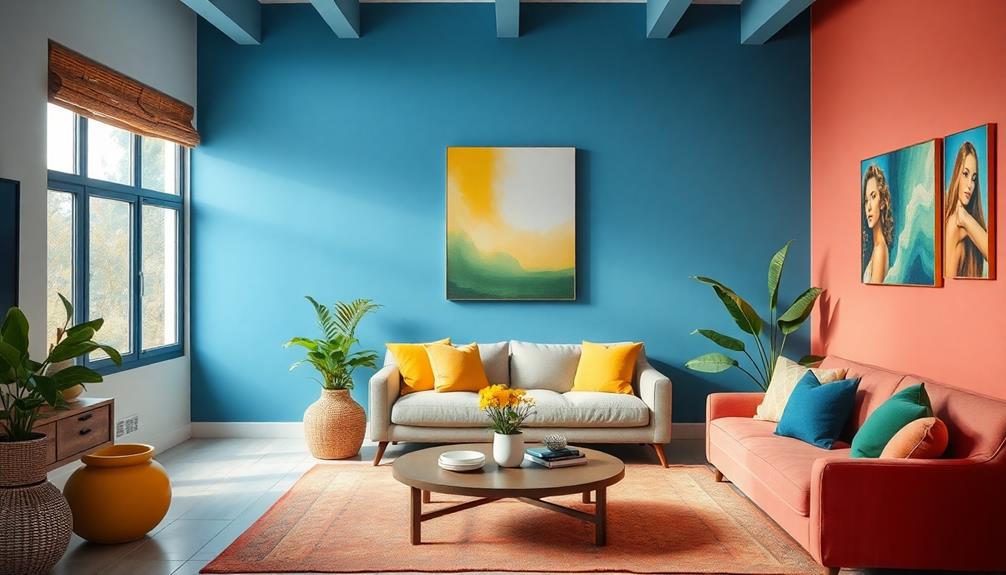
When choosing colors for your space, it's important to take into account their emotional impact and the elemental associations they carry. Each color can evoke specific feelings and enhance the atmosphere of a room, influencing how you and your guests feel in that environment.
For instance, incorporating vibrant colors and intricate patterns through Indonesian decorative pillows can't only add comfort but also reflect your cultural heritage.
Additionally, cultural significance can shape your perception of color, making it essential to choose hues that resonate with you and your lifestyle.
Emotional Impact of Colors
Colors are more than just visual stimuli; they can deeply influence your emotions and overall atmosphere in a space. Each color elicits unique emotional responses and can shift the energy of your environment.
For instance, vibrant reds can stimulate passion and energy, making them perfect for dynamic living spaces or workout areas. If you're seeking tranquility, consider blues; they promote calmness and relaxation, ideal for bedrooms or meditation rooms. Incorporating elements of traditional artistry through decor, such as Indonesian masks, can further enhance these emotional impacts by adding layers of cultural significance.
Green symbolizes growth and healing, making it an excellent choice for rejuvenating spaces like home offices or wellness areas. Meanwhile, warm colors like orange and pink uplift your mood and encourage happiness, perfect for social areas where interaction thrives.
Yellow and gold evoke power and wisdom, enhancing clarity and nurturing qualities, which are beneficial in kitchens and study rooms.
However, remember that deeper blues can promote introspection and wisdom but may also symbolize mourning in certain cultures. This highlights the importance of context in your color choices.
Elemental Color Associations
Understanding elemental color associations can dramatically enhance the energy of your space. Each color corresponds to one of the five Feng Shui elements, influencing the atmosphere and emotional responses within your environment.
For instance, blue and black represent Water, promoting calmness and creativity, making them ideal for spaces designed for reflection or work. Incorporating traditional Indonesian style home decor can further amplify the connection to nature, enhancing the calming effects of these colors.
Green symbolizes Wood, which is all about growth and internal change—perfect for areas where you seek personal development.
Red, linked to the fire elements, injects energy and passion into social spaces. Use it sparingly, though, as too much can create tension.
Yellow, representing Earth, enhances clarity and stability, making it a great choice for kitchens or study areas.
For focus and purity, white and metallic colors are your go-to options. These shades support concentration and can brighten up a room, creating a sense of cleanliness.
Cultural Color Significance
Exploring cultural color significance reveals how colors can deeply impact our emotions and experiences. For instance, the color red is often linked to energy, passion, and luck across various cultures. You might consider using it for accent pieces or on your front door to attract positive vibes.
Additionally, incorporating vibrant colors, such as those found in Indonesian decor masks, can enhance the cultural richness of your space. In contrast, shades of blue, especially deeper tones, evoke calmness and wisdom, making them ideal for bedrooms or meditation areas. Lighter blues can be particularly inspiring in workspaces, promoting creativity.
In your living rooms, yellow and gold can uplift the mood, symbolizing power, health, and happiness. These colors encourage interaction and make social gatherings more enjoyable.
If you're leaning towards a more sophisticated look, incorporating black can offer a sense of mystery and contemplation. While it may symbolize mourning in some cultures, used thoughtfully, it can also promote career success.
When choosing colors for your space, consider these cultural meanings. Aligning your color choices with their significance can enhance the energy of your environment and support your intentions, creating a harmonious and inviting atmosphere.
Effective Color Combinations
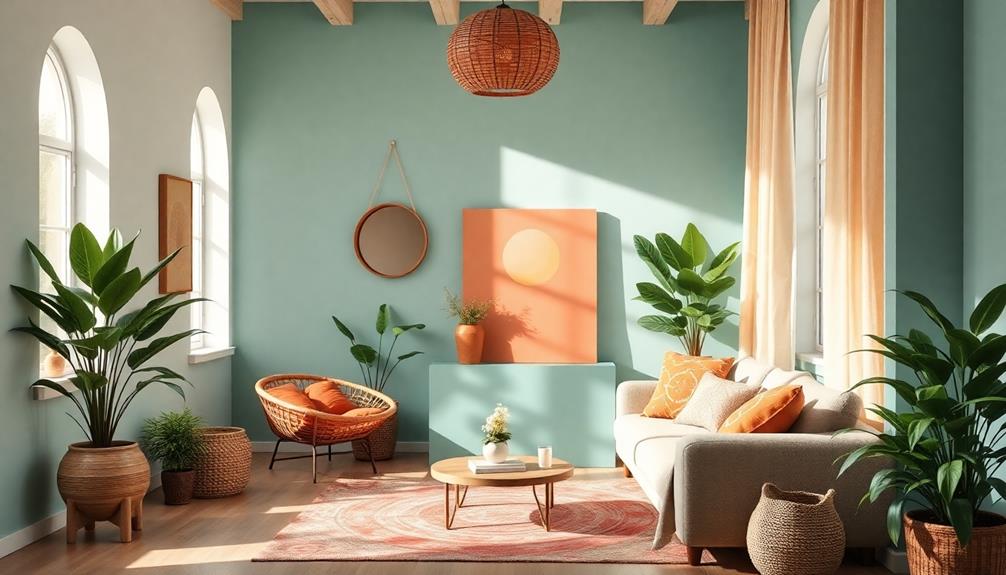
When you select effective color combinations, you can greatly influence the mood and energy of your space. For example, pairing blue (Water) with green (Wood) can promote growth and creativity, making it a colorful choice for a home office or creative studio.
If your living room needs a boost in social interaction, consider combining warm colors like salmon. This blend harmonizes earth and fire elements, encouraging conversation and connection among guests.
Turquoise is another fantastic option, as it merges water and wood energies, ideal for spaces meant for movement and growth.
Layering different textures and materials with your chosen colors can elevate the ambiance, making your environment feel more inviting and balanced.
Don't forget to test various color pairings under different lighting conditions. This step is essential to assess how colors interact and to guarantee they evoke the desired energy in your space.
Practical Home Decor Suggestions
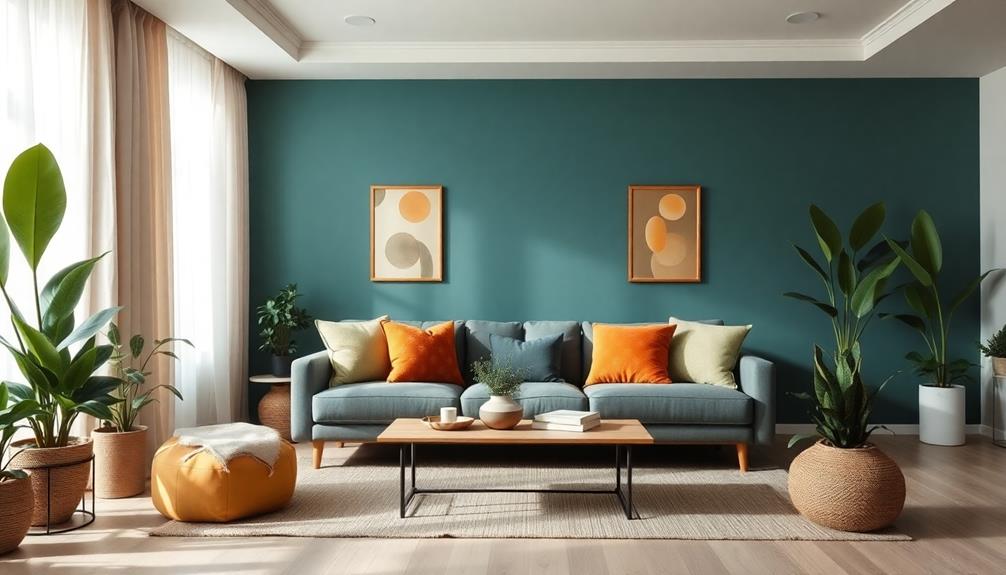
Creating a well-designed home starts with practical decor suggestions that cater to both aesthetics and functionality.
Begin by incorporating calming colors like blue or green in your home office. These shades enhance focus and productivity while keeping the energy balanced. When selecting paint, test multiple shades under different lighting conditions. This helps you see how colors interact with your space before making a decision.
For accent pieces, choose colors that reflect the intended mood of each room. Warm tones work well in social areas, while cooler hues create relaxing spaces.
In bedrooms and living areas, opt for earth tones and muted shades to cultivate a serene environment that promotes rest.
Layering different textures and materials with your chosen color palette can further enhance the overall design. This not only adds visual interest but also balances the energy flow in the room.
Don't forget to incorporate colorful decor items like cushions or artwork to bring personality to your space, ensuring it feels inviting and vibrant.
Color Selection for Different Rooms
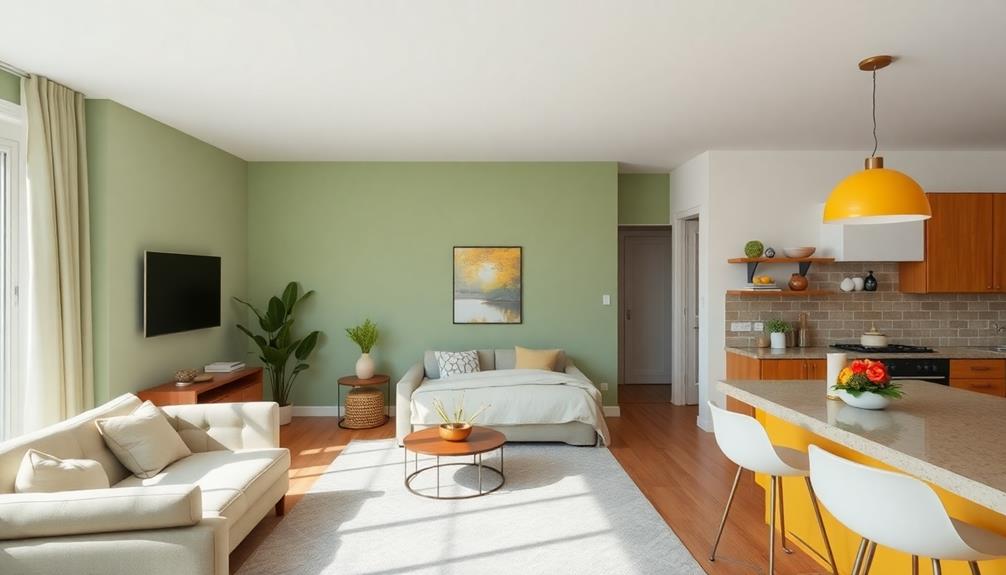
When selecting colors for different rooms, consider how each hue affects your mood and activities.
For instance, calming shades in the bedroom can promote restful sleep, while warm tones in the living room encourage lively conversations.
In your home office, choosing colors that boost focus and creativity will help you stay productive throughout the day.
Bedroom Color Recommendations
Choosing the right colors for your bedroom can greatly impact your mood and sleep quality. To create a serene atmosphere that promotes relaxation, consider the following recommendations:
- Soothing Colors: Soft blues and greens align with the calming properties of the Water element, helping you unwind and sleep better.
- Muted Lavender: This color enhances spirituality and tranquility, making your space feel more peaceful and inviting.
- Earthy Tones: Shades like beige or light taupe provide stability and nurturing qualities, fostering a sense of security in your personal haven.
- Gentle Pink Hues: Incorporating these colors promotes love and romance, perfect for couples looking to enhance their connection.
Be mindful of your choices; while vibrant colors can energize a room, using them sparingly as accents avoids overwhelming your space.
By selecting these colors, you can create a harmonious bedroom that not only looks beautiful but also supports restful sleep and emotional well-being.
Living Room Energies
In the living room, color selection plays a crucial role in shaping the overall energy and atmosphere of the space. To create a welcoming environment, consider warm colors like red, orange, and yellow. These hues enhance much fire energy, encouraging lively interactions. However, use bold reds sparingly—limit them to no more than 1/9 of the room to prevent overwhelming energy.
To foster deeper emotional connections among family members, incorporate earthy tones. These shades provide stability and comfort, balancing the vibrant fire energy. Additionally, using accents of blue or green promotes water energy, offering a calming effect that encourages creativity and communication amidst the lively atmosphere.
Here's a simple guide to help you visualize:
| Warm Colors | Earthy Tones | Accents |
|---|---|---|
| Red | Brown | Blue |
| Orange | Beige | Green |
| Yellow | Olive | Teal |
Office Color Strategies
After creating a vibrant living room atmosphere, it's time to focus on your home office, where color plays a significant role in enhancing productivity and focus.
Here are some effective color strategies to contemplate:
- Shades of Blue: Use calming shades of blue to promote concentration and a sense of tranquility. This color is linked to the Water element in Feng Shui, making it ideal for deep thinking.
- Green Tones: Incorporate green to symbolize growth and action. This color fosters productivity and encourages internal change, creating a dynamic workspace.
- Warm Colors: Add warm colors like red and orange as accent pieces. These hues can stimulate energy and creativity but should be used sparingly to prevent overwhelming the space.
- Neutral Colors: Combine neutral colors with vibrant accents for a balanced atmosphere. Soft yellows can provide clarity, while neutral tones support both focus and relaxation, making your office a nurturing environment.
Elemental Relationships in Color
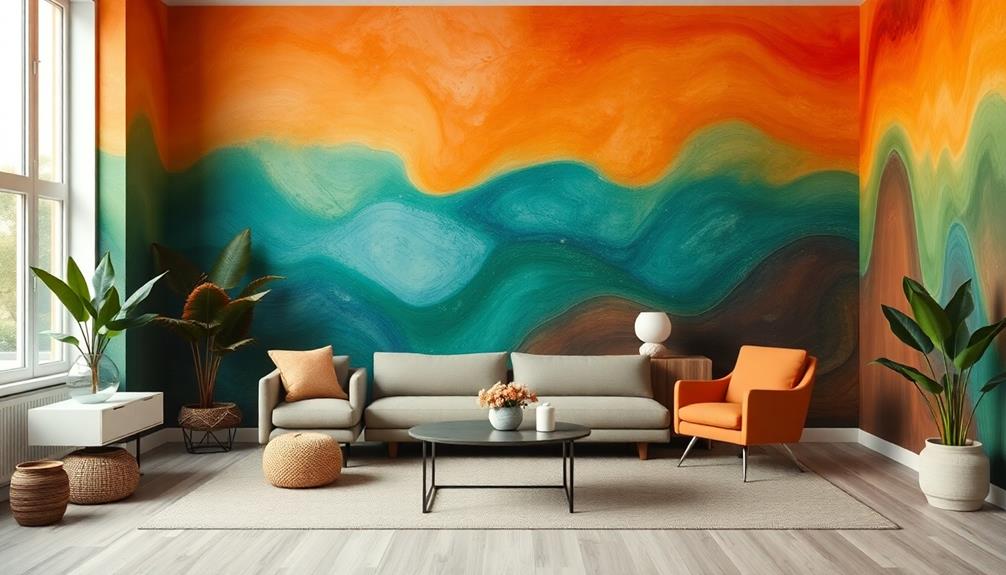
Colors play an important role in shaping the energy of your space, and understanding their elemental relationships can transform how you feel in your environment. In Feng Shui, each color corresponds to one of the five elements, influencing the overall energy. For instance, the wood energy represented by green promotes growth and liveliness, while the fire element embodied by red brings warmth and passion.
When choosing colors, consider the creative cycle of elements. Fire fuels Earth, which produces the metal element, allowing you to create a harmonious flow. For instance, using red in your living area can enhance the warmth you want while supporting earthy tones that ground the energy.
Conversely, be cautious of the exhaustive cycle where elements weaken one another. Fire can weaken wood energy, so using too much red in a space meant for growth may hinder your intentions. Instead, balance the colors to guarantee they support your goals.
Understanding these elemental relationships will guide your color choices to enhance the desired energies in your space, aligning with the direction and purpose you have in mind.
Emotional Impact of Colors
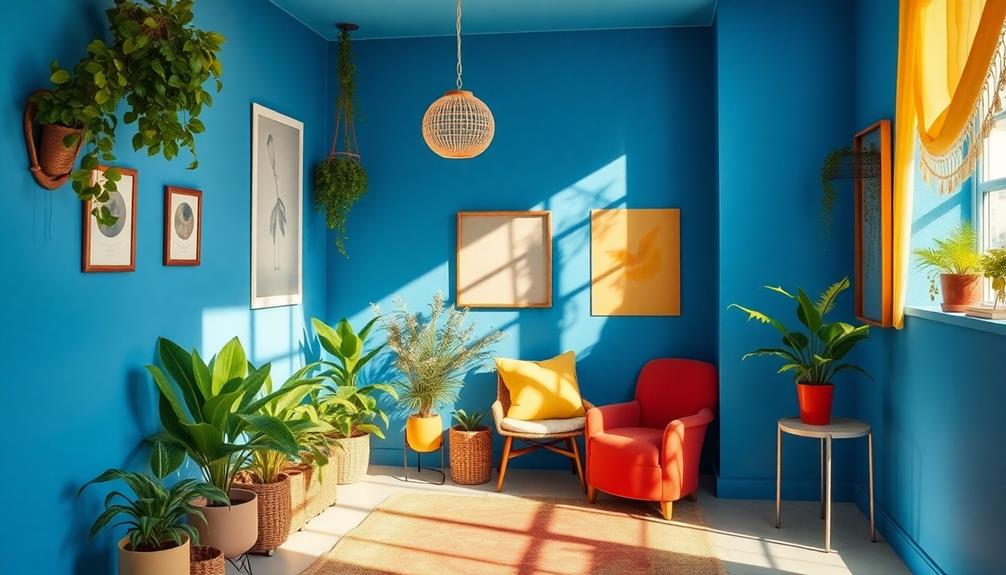
The emotional impact of colors is profound, influencing how you feel and behave in your space. Choosing the perfect color can evoke specific emotional responses that enhance your environment.
Here are some colors and their emotional effects:
- Red: Stimulates energy and passion, making it great for spaces where you want to feel motivated.
- Blue: Promotes calmness and concentration, ideal for workspaces or bedrooms where tranquility is essential.
- Green: Symbolizes growth and healing, perfect for creating relaxing areas dedicated to wellness.
- Yellow: Associated with clarity and optimism, it enhances your mood and fosters a nurturing atmosphere.
Keep in mind that the significance of a lucky color can vary culturally. For example, deeper blues may be linked to mourning in some cultures, highlighting the importance of context when selecting your hues.
By understanding the emotional impact of these colors, you can transform your space into a sanctuary that resonates with your feelings, enhancing both your well-being and productivity.
Choose wisely, and let your colors work for you!
Strategies for Color Experimentation
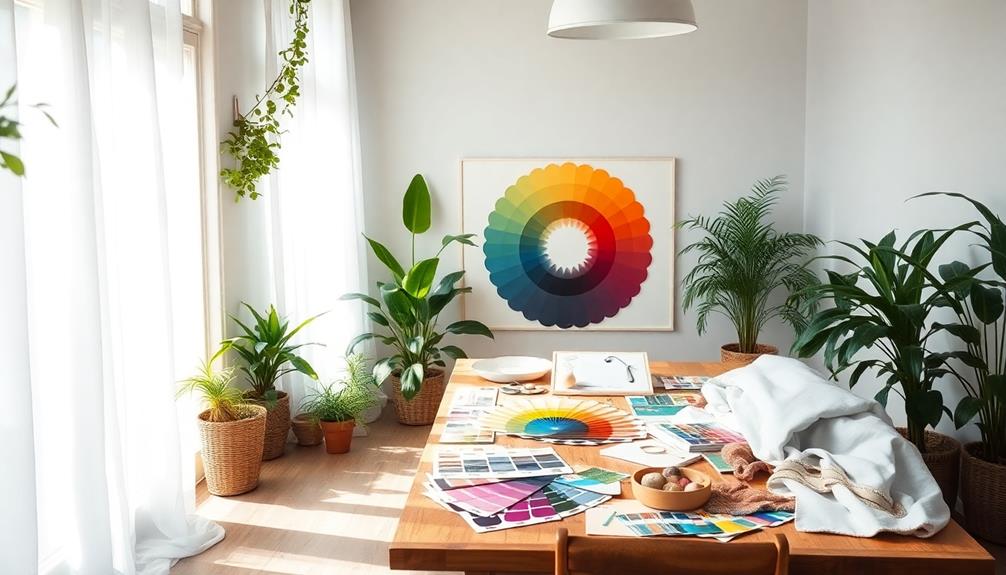
When it comes to experimenting with color in your space, adopting a playful mindset can lead to exciting discoveries. Start by layering different textures along with your chosen hues to enhance the calming effect and create a sense of warmth. This will invite a more comfortable atmosphere into your home.
Next, try using partial applications of stronger colors to avoid overwhelming your space. This approach helps maintain a balanced energy flow, ensuring your room feels stimulating without being chaotic. You can also experiment with various color pairings and trial different combinations to find the most effective blend that complements your home's purpose and aesthetic.
Don't forget to take into account your personal preferences and how you react to certain colors, as these can greatly influence the mood and functionality of your space.
Finally, make it a habit to reassess your color choices as the seasons change. Adapting your color schemes regularly keeps your environment fresh and harmonious throughout the year.
Frequently Asked Questions
What Are the Best Colors for Feng Shui Rooms?
For Feng Shui rooms, you'll want calming blues and greens in bedrooms, warm yellows and soft reds in living areas, vibrant greens in kitchens, focused blues in offices, and tranquil light blues in bathrooms.
How Do I Choose the Right Color for My Room?
To choose the right color for your room, consider its purpose, size, and lighting. Experiment with various shades, mixing warm and cool tones, and always test them in different light to find your ideal vibe.
What Are the Feng Shui Colors for Creative Space?
For a creative space, consider using orange to spark enthusiasm, yellow for clarity, green for growth, purple for inspiration, and turquoise for a dynamic atmosphere. These colors foster creativity and enhance your artistic expression.
What Colors Are Best for Living Room Space?
When you're selecting colors for your living room, think of hues that evoke warmth and serenity. Soft reds and greens invite connection, while blues and muted purples add calm and sophistication to your space.
Conclusion
So, you've mastered the art of color selection with Feng Shui—congratulations! Picture your living room draped in the vibrant red of a dragon's fiery breath, while the kitchen sparkles with the cool calm of a blue iceberg. You've transformed your home into a colorful circus where harmony and chaos waltz together! Just remember, while you're busy balancing your yin and yang, don't let your walls start arguing over who looks better—because that's where the real disarray begins!
